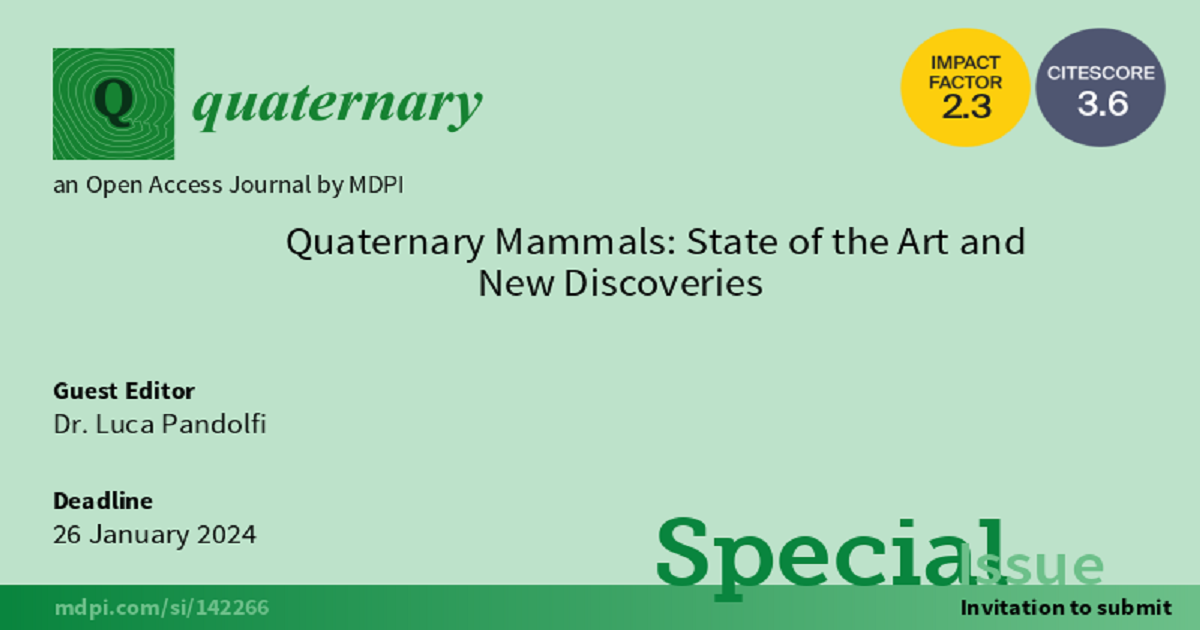- 2.1Impact Factor
- 4.1CiteScore
- 39 daysTime to First Decision
Quaternary Mammals: State of the Art and New Discoveries
Special Issue Information
Dear Colleagues,
The phylogeny and systematics of Quaternary mammals, as well as their paleobiogeography and biochronology, is often a matter of discussion among palaeontologists. Despite the long history of research on these topics, Quaternary mammals are still poorly understood, and a general consensus on validity and relationships within the different species, as well as their paleobiology, still seems far from being reached.
This Special Issue aims to provide a comprehensive overview as well as new hypotheses and observations on fossil Quaternary mammals; on factors that lead to their extinction, dispersal, and evolution; as well as their relationships with extant species.
Contributions are requested from any taxonomic group of Quaternary mammals from all over the World, including topics on morphological and morphometric characteristics useful to discriminate or validate fossil species based on the paleobiogeography and dispersal patterns of fossil groups, on chronological and biochronological occurrences, and on phylogenetic and palaeobiological investigations. Studies at regional and continental scale are particularly welcome. All authors will provide free access to the databases used for their studies, as supplementary files or free-access repositories.
Dr. Luca Pandolfi
Guest Editor
Manuscript Submission Information
Manuscripts should be submitted online at www.mdpi.com by registering and logging in to this website. Once you are registered, click here to go to the submission form. Manuscripts can be submitted until the deadline. All submissions that pass pre-check are peer-reviewed. Accepted papers will be published continuously in the journal (as soon as accepted) and will be listed together on the special issue website. Research articles, review articles as well as short communications are invited. For planned papers, a title and short abstract (about 250 words) can be sent to the Editorial Office for assessment.
Submitted manuscripts should not have been published previously, nor be under consideration for publication elsewhere (except conference proceedings papers). All manuscripts are thoroughly refereed through a single-blind peer-review process. A guide for authors and other relevant information for submission of manuscripts is available on the Instructions for Authors page. Quaternary is an international peer-reviewed open access quarterly journal published by MDPI.
Please visit the Instructions for Authors page before submitting a manuscript. The Article Processing Charge (APC) for publication in this open access journal is 1600 CHF (Swiss Francs). Submitted papers should be well formatted and use good English. Authors may use MDPI's English editing service prior to publication or during author revisions.
Keywords
- paleobiology
- morphology
- morphometry
- phylogeny
- biochronology
- paleobiogeography

Benefits of Publishing in a Special Issue
- Ease of navigation: Grouping papers by topic helps scholars navigate broad scope journals more efficiently.
- Greater discoverability: Special Issues support the reach and impact of scientific research. Articles in Special Issues are more discoverable and cited more frequently.
- Expansion of research network: Special Issues facilitate connections among authors, fostering scientific collaborations.
- External promotion: Articles in Special Issues are often promoted through the journal's social media, increasing their visibility.
- e-Book format: Special Issues with more than 10 articles can be published as dedicated e-books, ensuring wide and rapid dissemination.

